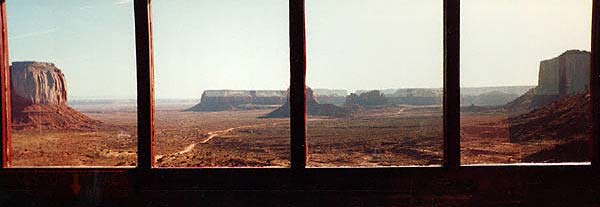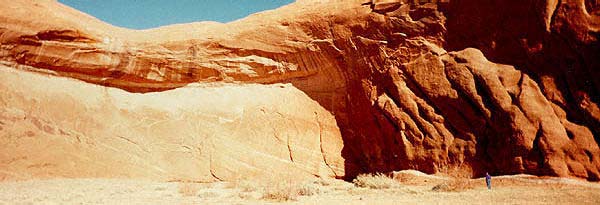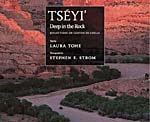
It was another magnificent Arizona [Hoozdo Hahoodzo] high desert morning ['abíní], but the Golden Sands wasn't open for breakfast [abínígo da'adánígíí] this Saturday [Damóoyázhí] morning ['abíní]! Nor were any of the other truly local eateries, so we were stuck with the Holiday Inn in Kayenta [Tódínéeshzhee'] for breakfast [abínígo da'adánígíí] for only the second time in my numerous trips there. While we waited for service, we could examine the totally tasteless, machine made items in the gift shop window that were being passed off as handmade craft items from the local area. It was more entertaining to watch the other occupants of the dining room [da'ad33góne'] and to speculate on their origins and the relationships between the members of their group. As is usual in this region, many of the visitors come from outside the United States,especially Europe and Japan. Between the Diné (the name the Navajo have for themselves, The People) and the foreign visitors, English speakers may be in the minority, that is those who speak only English. Today several German [bééshbich'ahí bizaad] speakers were present at breakfast, which finally arrived -- standard U.S. motel fare.
After filling the gas tank [chidí bitoo dahsi'ánígíí], we headed north [náhook-s] on 163, past the High School, which sometimes has grass so green that you cannot believe it against the red land, past Aglatha Peak ['Aghaa[3 ] and Owl Rock, toward the entrance to Monument Valley [Tsé bii'nidzisgai], just over the Utah [Gáamalíní bikeyah Hahoodzo] border. The loop drive in Monument Valley [Tsé bii'nidzisgai] can be traveled by a private car [chidí], but it is best done by one with high clearance. As we dropped down into the valley from the overview at the entrance, the view of the Mittens was spectacular. At each turn in the road, another incredible wind [níyol] and water [tó] carved red rock [tsé] butte would be revealed, the Three Sisters, Elephant Butte, Spearhead Mesa, the Totem Pole, and many more. More sand [séí] samples were taken. but, due to the cold weather [t'áá ákwííj8 ní[ch'ih 'a['22h 'ánáání[ígíí] and the general lack of tourists, the local residents were not much in evidence. We drove the loop slowly, stopping at all of the pullouts. When we returned to the Visitor center, there were a few local Navajos scouting the entrance area, hoping to act as guides for those not inclined to risk their cars [chidí]. We stopped at the visitor center where I purchased a Carlos Nakai tape (Ancestral Voices) to play in the car [chidí] (when not listening to KTNN, Window Rock [Tségháhoodzání]), a couple of bookmarks having panoramic views of the landscape and a disposable camera [bee ak'inida'anilí] which took panoramic photographs [naaltsoos bikáa'gi e'elyaa]. Lori got some postcards and a chocolate "fix" while I went upstairs to the enclosed overlook and took my first photograph [naaltsoos bikáa'gi e'elyaa] with the new camera [bee ak'inida'anilí].

We decided we had enough food [ch'iiyáán] in the car [chidí]
that we could skip lunch at the Holiday
Inn. Therefore we planned to drive on to the Chinle
[Ch'íníl8] area
without another stop in Kayenta
[Tódínéeshzhee'].
Just outside of the Monument Valley Tribal Park, near the
intersection with the highway, we passed the second Monument
Vally High School and turned south.
On our drive back to Kayenta [Tódínéeshzhee'], we saw the
aftermath of a serious, apparently one [[a'ii] car [chidí],
accident. The car [chidí] had rolled over
several times, to end up far off the road ['atiin], leaving glass from
the car windows [chidí bitsés-'] everywhere. We saw no
sign of occupants and no ambulance, but there were two Navajo Nation patrolmen and no reasonable
scenario for the cause of the accident. However it is open range. We kept a
careful eye on the roadside for sheep
[dibé], horses
[[88]
or the occasional cow [béégashii].
We also checked our seatbelts. The accident
reminded us of the Christmas Story
![]() we found in one of the local papers that we had picked up.
we found in one of the local papers that we had picked up.
After passing by the Monument Valley High School in Kayenta [Tódínéeshzhee']
again and driving through the town, we turned onto US 180
east [ha'a'aah] and drove past
Church Rock and past our turn
in order to see the Baby Rocks [Tsé 'awé'é] formation, an
unusual erosion/fracture pattern in a deep red [[ichíí'] mesa. We turned around there and returned
to the intersection with Navajo Rt. 59, south [shádi'ááh]
toward Chinle [Ch'íníl8].
As we drove south
[Shádi'ááh]
toward Chinle [Ch'íníl8],
with Black Mesa
[Dzi[yíjiin]
ever closer on our right
[nishnááji],
past Chilchinbito
[Chii[chin bii'tó], we found the body of a
dog [lééch2<2'í]
hanging from a roadside marker.

After passing White Top Mesa, where the fracture forms always remind me of the spirit gods of the Navajo [Yéi] as portrayed in sandpaintings [iikááh] and rugs [diyogí], we were forced to detour onto a well made dirt road winding down the face of a mesa. The deep cut that had been made in the mesa to accomodate the highway ['atiin] had washed out. Shortly after the detour, we passed the road into the town of Rough Rock [Tséch'izhí].
Just before we reached Many Farms [Dá'ák'ehalání], while driving over the Carson Mesa, I turned off onto a dirt road and drove into an open area under high cream [dinilgai] colored rock [tsé] cliffs. I knew this hidden amphitheater because Steve and I had explored this region when we taught at Navajo Community College in Tsaile for two [naaki] summers [sh8 sh98go]. Lori and I had lunch here and spent some time exploring the area. Lori took more sand [séí] samples, still finding new colors ['a[tah 'áát'ee[go nidaashch'22'ígíí] !

After lunch we descended into the Chinle Valley to the town of Many Farms [Dá'ák'ehalání] and followed US 191 and the Chinle Wash into Chinle [Ch'íníl9]. I decided that I must show Lori a few of the off the beaten path spectacular sights of the area -- south [shádi'ááh] down the valley, known as Beautiful Valley places where no tourist is ever seen. We drove south [shádi'ááh] from Chinle [Ch'íníl9] on Navajo 27 toward Nazlini [Nazlíní] on a good dirt road, but one which can turn into a quagmire when wet [dinisht[éé']. We first drove past Nazlini [Nazlíní] and up onto the Defiance Plateau to another unmarked pullout and into an ex-picnic area (at least there are things that were once picnic tables there), littered with broken glass, crushed cans and used diapers, to reach a viewpoint overlooking a deep maroon red [di[hi[go [ichíí'] fluted rock [tsé] canyon with a wooded top. We could see for miles (50 -- 75) in the clean dry winter [haigo] air.
After a discussion of the proclivity of Westerners to believe in the inexhaustability of the landscape, we made our way back out and drove down toward Nazlini [Nazlíní] and the Chinle Wash. But half way down I stopped at another overlook, south [shádi'ááh] down the valley, known as Beautiful Valley to the Diné. This view is incredible, no matter what the season [nináhágháhígíí]. Driving on past Nazlini [Nazlíní], I turned left [nisht['ahjí] at the intersection, toward the road ['atiin] connecting to US 191. This road ['atiin] passes through an incredible set of huge mudhills covered with petrified wood. We spent hours here, walking over the mudhills. I collected small colorful pieces of the petrified wood for my grandaughter's new rock tumbler. Lori collected larger pieces for her ever-growing collection of land samples, and we just enjoyed the gorgeous winter [haigo] afternoon ['a[ní'ní'3dóó bik'ij8'].
As I walked back to the car [chidí], I noticed that we had
a flat tire [chidí
bikee' níí[ts--z]. Lori and I spent
half an hour ['a[níí] trying to find the nut which would allow us to release the spare tire [chidí bikee']
from its storage space under the rear of the car [chidí]. We finally found instructions
on a piece of paper [naaltsoos] stuck on under the hood [chidí bitsiits'iin bi[ yaa si'ánígíí]
(where the jack [chidí bee dah![]() díídlohí] was stored!), no thanks to
Avis. Their instructions were useless! Once we could get the spare out, it took us no
time at all to change the tire [chidí bikee'].
While doing so, Lori told me about the large log of
petrified wood that she had seen when standing on top of the highest mudhill, the
size of a Yule log! We left it where it belonged.
díídlohí] was stored!), no thanks to
Avis. Their instructions were useless! Once we could get the spare out, it took us no
time at all to change the tire [chidí bikee'].
While doing so, Lori told me about the large log of
petrified wood that she had seen when standing on top of the highest mudhill, the
size of a Yule log! We left it where it belonged.
On the way back��� to town, Lori and I speculated on how we would get the tire [chidí bikee'] repaired on a Saturday [Damóoyázhí] night [t['éé'] in Chinle [Ch'íníl9]. We worked out our schedule so we could get it fixed on Monday [Damóo biiskání] morning ['abíní] if necessary, while driving carefully over the weekend. We would be more like an Indian car, without a spare. The first gas station [chidí bitoo' bá'a'íí'áhí] at which we stopped didn't fix tires [chidí bikee'] but did tell us the location of one which would. By now I was again adept at asking the right questions [na'ídíkid] in order to get the information desired, so we drove on to the second station and inquired about getting the tire [chidí bikee'] fixed. The young Navajo attendant [chidí bitoo' iihnáyiikaahí] said "sure, we fix tires [chidí bikee']." We supposed that we would leave the tire [chidí bikee'] to be fixed and pick it up later. But no, the attendant [chidí bitoo' iihnáyiikaahí] turned into a mechanic [chidí 'aneilíni]. The tire [chidí bikee'] was instantly examined and repaired. All the while he quizzed us about how it happened. What were we doing down there in Nazlini [Nazlíní]? Did we like Chinle [Ch'íníl9]? He thought it was too small. (We felt that was an definite advantage.) He told us about his son who was in the hospital [azee'ál9] and how many hours ['ahéé'ílkid] he had worked today (since 7 AM! [tsosts'idi'azl99']). But all this time the tire [chidí bikee'] was quickly and efficiently fixed. We were set for the weekend.
We needed to do a little more shopping to replenish our supplies, and Bashas' is a required stop in Chinle [Ch'íníl9] because the market supplies more than one need for the local people. Many of the people who shop here come from miles away and see friends while there that they are not often able to see. Therefore, as opposed to a bunch of scurrying housewives (or people from two earner families) trying to get a few things for dinner, we find many men [hastóíní], mostly older [hastóínísání], and a few older women [Sáannínísání], standing by the doorway or just inside looking over the new arrivals for old friends [ak'is]. Inside family groups are scattered through the store gathering things they need. This supermarket supplies an elevated lounge area where shoppers and family members can go to sit and talk or just observe the activity on the floor of the store at the same time, an accomodation to the local customs.
We got into a checkout line and waited our turn, smiling at the numerous small children ['á![]() chíní],
their mothers [shimá] and grandmothers [shimásání] (maternal). As we got closer, we noticed that the cash register announced each
item and its price -- out loud! This soon began to get on our nerves. We couldn't believe
that the cashiers could put up with it. Perhaps they got frequent breaks or maybe they are able to
tune out English! When we paid, we found that we got Bashas'
Gold Stamps. I wanted to give them to someone who could use them, as I usually do, but we didn't find
a good opportunity to do so.
chíní],
their mothers [shimá] and grandmothers [shimásání] (maternal). As we got closer, we noticed that the cash register announced each
item and its price -- out loud! This soon began to get on our nerves. We couldn't believe
that the cashiers could put up with it. Perhaps they got frequent breaks or maybe they are able to
tune out English! When we paid, we found that we got Bashas'
Gold Stamps. I wanted to give them to someone who could use them, as I usually do, but we didn't find
a good opportunity to do so.
This supermarket also stocks a large supply of tape cassettes. We examined the available stock of Native American music tapes and chose two, Russell Mean's "Electric Warrior" as a gift for a friend back in Massachusetts who would appreciate it, and a tape of powwow music to accompany us on our travels as an occasional alternative to KTNN.
We then drove on to the Thunderbird Inn and checked in. After a quick wash up, we went to dinner in the cafeteria. Lori had a bilagáana dinner (barbequed ribs ['áts33a']) while I had mutton stew [atoo'] and fry bread [dah díníiilghaazh]. The dining room walls are covered with an incredible array of fine Navajo rugs [diyogí], including cases full of miniature rugs [diyogí] only a few inches in length. There were also excellent sandpaintings [iikááh] on display. We visited the gift shop after dinner to wind down before going to bed [bikáá' dah'anitéhí]. Lori asked about the yarn for sale there, and bought some for a friend. Several local women [asdzání] made yarn purchases while we were there. The older women ['asdzáán] begin their rugs [diyogí] by tending the sheep [dibé] and making their own yarn from the wool ['aghaa'] they obtain at shearing time. They also make their own dyes from locally collected materials, a very time consuming process which greatly decreases the return (in price/hour of labor) on the sale of a rug [diyogí]. The younger women [asdzání] apparently choose to purchase their yarn finished.
There is now cable television [ni[ch'ih naalkidí] in the rooms at the Thunderbird (it used to be a quiet haven from the
outside world),
Lori was able to checkup on the UMass basketball game [joo[ bee nida'anéhí] results again before turning out the
lights.
 New! Tséyi'/Deep in the Rock: Reflections on Canyon De Chelly,
New! Tséyi'/Deep in the Rock: Reflections on Canyon De Chelly,
Laura Tohe and Stephen Strom (photographer), Univ. Arizona Press.
Navajo Spaceships, Star Mountain and Rez Memories, An Online Writing Journal, Prose & Poetry by John Rustywire, Navajo
Antelope House Tours a Navajo owned business offering 4 x 4, horseback and hiking tours of Canyon de Chelly, including overnight stays in the canyon.
A page linking to the personal stories of several Navajo rug weavers and other craftspersons is available. Links to three of them were available above.
A page with information on satellite images of this area is also available.
The recording of Indian Cars go Far, from Electric Warrior by Russell Means, is used with the permission of the Soar Corporation. The entire song may also be heard in RealAudio.
Subscribe to American Indian Art Magazine
Arizona Highways
References
Books on Navajo Rug Weaving
Music & Videos
Visit The Sonoran Desert 5000 square miles of silence.